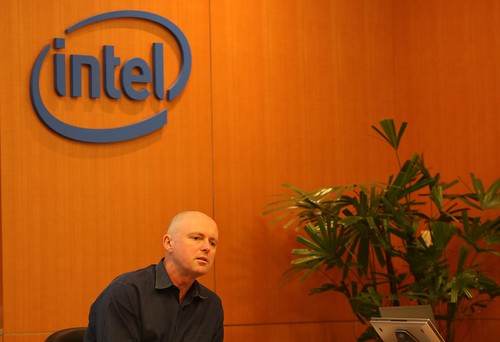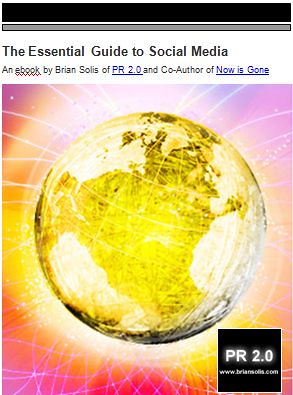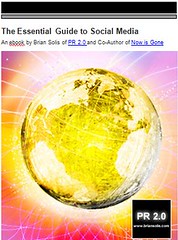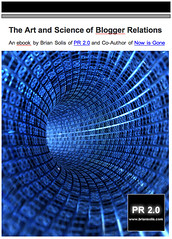Chad Hurley on the Rise, Acquisition, and Future of YouTube
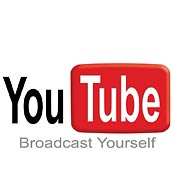
Social Media is our genre's Industrial Revolution. It is the era of new influencers and the ability for everyday people to share their creativity, expertise, thoughts, ideas, and passions in order to participate in and build a community around common interests.
People are taking their destiny into their own hands and evolving their online, personal or professional, persona and brands online.
While there are many user-generated or people-driven social networks today, none generate the mainstream traffic or exposure possible at YouTube.
It has created stars, launched careers, extended brand reach and resonance, cultivated communities, promoted causes, and even helped politicians garner votes. YouTube has also created an entirely new platform for creating, discovering, sharing, and viewing content that might have otherwise never made it into the public spotlight.
YouTube has inspired an entirely new generation of producers, stars and also marketers with videos earning hundreds of thousands and millions of views and fans in the process. (see below for examples of people who transcended their Internet famous status into real world fame, and hopefully one day, fortune.
The other night, I had the opportunity to attend a private event that was host to a very special speaker, Chad Hurley, co-founder of YouTube. Hurley shared his experiences from inception to acquisition, and also touched upon the future of YouTube.
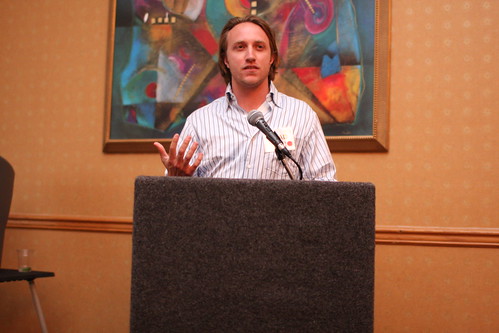
I’ll share some of the highlights from his trip down memory lane and also some of his insights and lessons learned along the way.
In the pre-launch days of YouTube, the team was absolutely focused on creating a video startup, but their business model and target markets were unclear. However, they soon realized that they needed to create a video upload site around a community, much in the same way Flickr was enjoying success with photos.
After a few days, the team brainstormed a good name and a memorable and consumer-friendly logo, which Chad actually designed. For those who don’t already know this, Hurley’s background is in design and it’s his attention to detail that provides the necessary perspective to accurately and successfully influence the look and feel, consumer friendliness, and new features implemented at the site.
Everything from the name, logo, and look was about popular culture. And as Hurley put it, “It was a chance to affect people’s lives.”
Like most startups, YouTube employees worked from their homes as well as the token garage that housed many startups over the years – going back to the early days of HP’s path to history.
They employed roughly 8 - 10 dedicated enthusiasts who were working without pay. Hurley told them, “that we’d work it out.” But, more importantly, he shared his tips for inspiring a team, especially a team not earning wages. This is the sweat equity that transforms into a form of real capital.
Chad emphasized, “The team believed in the project and in each other. It was about trust and friendship.”
He also reminded entrepreneurs that the biggest challenge of any startup is to find the right people to build a successful company, “You need a team to work well together to make it a reality. It’s the thing you can’t lose sight of. And, have fun along the way.”
The pains associated with the company’s early days would quickly become stories that they would tell to friends and family (and attendees at conferences) as a distant, but inspiring story.
Once YouTube hit the blogosphere and Slashdot, they never looked back.
Almost immediately, according to Chad, “the team evolved from the garage to working and eating at Sequoia’s office – the company’s initial investor.”
While at Sequoia’s office, YouTube hit one million video views per day.
His story for seeking YouTube’s Series A was fascinating and almost goes against everything entrepreneurs are conditioned to believe and follow.
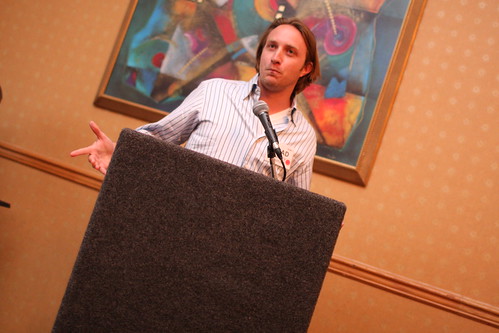
The company started in January 2005 and closed its first round in November. They opted to bypass angel funding because they needed the level of financing that would help them scale along with the intense requirements that Web video demands.
“We didn’t have a presentation, we had a product and stats,” explained Hurley. “It wasn’t a business idea; it was a solution that we were pitching. We skipped the entire angel process because it was going to be expensive to store all of these videos.“
After making the rounds up and down the infamouse Sand Hill Road, the team secured its first round of $3.5 million through Sequoia and its network of Paypal contacts. This initial round was enough to build out the infrastructure they needed to grow and be successful – for the time being.
I didn’t get a chance to ask, and perhaps if Chad reads this, he can reach out…my question is, did the Paypal connections allows them to cut corners? Obviously, Roelof Botha of Sequoia saw the vision, but what was the response from other VCs? Did they get it or would business plans and presentations have helped bring others onboard? What was the back story on the reaction of others?
As the company grew, the team realized that they might be onto something much bigger. Early on, Nike had a breakout hit with a soccer video. Hurley, Steve Chen and investor Roelof Botha went to Nike HQ in Oregon to talk about it. Although nothing came from the meeting, the team realized that YouTube could play host to commercial solutions in addition to personal use – helping people and brands reach a mass audience.
Concurrently, the team’s resources were focused on creating a community that fostered the discovery and sharing of videos and also protecting or removing the content based on the owner’s rights. Chad mentioned that one of YouTube’s biggest differentiators, a milestone that the press usually misses, is that YouTube was one of the first companies to automate the DMCA process.
While, there are now hundreds of competitors, YouTube has and always will be focused on building solutions for consumers, businesses, the industry, and also the content. They’re dedicated to providing free and legal ways to use content, and as Hurley explained, “Really what it comes down to, what people miss, is that we created a community around video – and it continues to grow to this day.”
As the company grew wildly, so did their reliance on scale, servers, and people. YouTube’s Series B extended the life of the company, but not indefinitely. As the company grew, they were always facing bandwidth, growth, and storage issues. Raising another series of financing later in the company’s lifespan appeared as a less attractive proposition.
Just to give you an idea of the infrastructure required to support a seemingly never-ending onslaught of video, the company today serves hundreds of millions of videos a day and receives over 13 hours of video every minute, and they’re still in the process of growing.
When it came to the state and future of advertising and online video, his honesty was also refreshing. As he pointed out to those wondering about revenue and monetization, Hurley expressed, “The ad market for online video is just developing. YouTube has only been around for three years. Traditional media has had 50+ years to work on its business model. One of the nice things about working with Google, is that we’re on the same page for monetizing content.”
The audience goes where the video is, and that’s why a library of content is critical. It creates and facilitates a network effect. Since its inception, YouTube wanted to build a community that was easy to use, and that philosophy continues today.
The company moved from San Mateo to San Bruno on the day the Google deal was officially announced. A funny little story he shared, is that the press showed up to their old office, allowing them to elude reporters.
What many didn’t realize is that the deal was actually closed within two weeks. It was an important decision to make, and it really came to a head the weekend before it was announced. But they knew it was the right thing to do.
Chad admitted, “I’m not sure any of this would have been possible without Google. Even today, they still let us run things our way, which is how we can keep our culture alive, not only in our office, but in the YouTube video community as well.”
YouTube continues to expand and grow at a blinding pace. The YouTube team, at the very beginning, wanted to create something that would allow people to create a real community around video. But in his own words, “We never anticipated when we started this site we would have such a profound effect on popular culture, that really just by unlocking this video solution and creating this global audience behind what we were doing, we’re really just enabling so many more people to express their views, not only their talents, but to get a message out there, and that’s what really drives us.”

He continued, “What continues to inspire us is that we’re providing an opportunity to prove the experience and express their views, help people monetize content, help candidates in political races, help people make money. We’re supporting and fostering creativity. We’re taking talent to the next level and helping people sign a record contract or a TV deal.”
Hurley provided a brief glimpse into what’s next for YouTube. The company views the community as a platform and through its API program, they plan on making that platform portable and pervasive. The future of online video is the ability to access it across the landscape of popular convergence appliances, such as the iPhone, TIVO, AppleTV, etc.
“We want to make YouTube a super distribution hub for your media, available on every device, around the world, in any language.”
The company is also innovating around its upload API to make it easier for people to share content outside of the PC. One such example is in gaming. The highly anticipated game of the year is Spore, and YouTube integrated its uploader for gamers to capture and upload gameplay directly to YouTube.
“We’re opening it up to expand the experience,” Hurley exclaimed.
Ultimately YouTube is an incredible story, one that is still being written today.
The founders and the team, built a system that relied on the community and as such, provided people with the tools to protect that community. To date, it’s one of the largest proactive communities online. Without content, there would be no community. And, viewers are the enabling force that determines the popularity of that content.
Now employing up to 350 people, the team continues to focus on its original premise. They’re providing solutions for people and businesses to share their stories, visually.
Chad and Steve created a new genre of storytelling, which has influenced the evolution of communities, communications, branding, advertising, broadcast media, and entertainment. It’s changing the game and forcing traditional media to adapt the new rules of engagement that companies such as YouTube, Flickr, and other community-powered networks are creating.
Most importantly, YouTube is leading the way for people to create their own destinies using video. We’re empowered with the tools and the community to express our creativity, thoughts, expertise, ideas, and passions, and with a little luck and strategic marketing, we can cultivate communities around our personal and professional brands.
YouTube, Broadcast Yourself.
People Who Have Leveraged YouTube to Create Their Own Celebrity
Kina Grannis
Marie Digby
Amber Lee Ettinger aka Obama Girl
Jessica Rose aka LonelyGirl15
Tom Dickson of Blendtec aka WillItBlend?
Liam Kyle Sullivan, Shoes
Andy McKee
The Evolution of Dance
OK Go
Chris Crocker
Journey discovers Arnel Pineda through YouTube
Arnel Pineda with Journey on Ellen
See my album on flickr for more pictures from the event or visit bub.blicio.us.
Connect with me on Twitter, Jaiku, LinkedIn, Tumblr, Pownce, Plaxo, FriendFeed, or Facebook.
About Startup2Startup:
Dave McClure lives up to his online persona of the Master of 500 Hats. He’s a successful entrepreneur, angel investor, conference organizer, connector of incredible people, and overall, a tremendous resource to the startup community. The group meets monthly over dinner to discuss relevant topics in technology and entrepreneurship, connect with new people and companies, and most importantly share real world knowledge and experience – successes and failures.
Dave’s latest endeavor, Startup2Startup, is a monthly series of intimate, very exclusive, and incredibly valuable conversation-based dinners.
youtube chad+hurley video viral brian+solis lonelygirl15 pr+2.0 pr2.0 journey arnel+pineda social+media social media media+2.0 media2.0 chris+crocker ok+go the+evolution+of+dance Liam+Kyle+Sullivan willitblend obama+girl obama marie+digsby digg digg+girl girl kina+grannis

